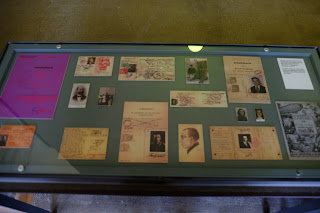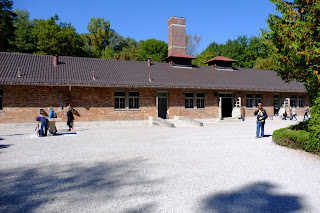This house was the former commandants offices
The Jourhaus served as the main exit and entrance to the prisoners’ camp and as the main office of the camp SS personnel. Passage through the building was made possible by a rod iron gate, through which the prisoners entered the camp after their initial arrival, and later marched through each day with their labor units. The gatehouse separated the
prisoners from the outside world.
The Shunt Room-As you view the contents in the tables that divide the rooms, you will notice that the first four tables display objects from the perspective of the prisoners, as they surrendered their personal effects, and in essence, their individuality. The last four tables show artifacts from the perspective of the SS officers, as they issued the prisoners numbers, stripping them of their individuality.
The Exhibition Museum

The main exhibition focuses on the fate of the prisoners. The leitmotif is the “path of the prisoners”: this refers to the path by which the prisoners came to the camp, their life in the camp, and their journey to either death or liberation.

The main exhibition focuses on the fate of the prisoners. The leitmotif is the “path of the prisoners”: this refers to the path by which the prisoners came to the camp, their life in the camp, and their journey to either death or liberation.
The tour guide standing where the prisoner baths were located
 |
| One of many photos that were on the wall of rememberance from this horrific day |
 |
Memorial statue for the victims of the
death marches in Dachau
|
Courtyard and Bunker was located between the rear of the maintenance building and the prison block; it was used for carrying out punishments, torture, or executions.
Maintenance building, situated on the Alte Römerstraße, are the Memorial Site’s administrative offices, the archive, library, and seminar rooms.
Mortal Agony of Christ Chapel from 1960 was the first religious monument to be erected.
The Protestant Church of Reconciliation was dedicated on April 30, 1967. The building is set into the ground of the memorial site leading the visitor beneath the surface.
 |
| The Old Crematorium |
The New Crematorium
The Death Chamber
 |
 |
| The Waiting Room this area was where the victims were to be informed on using the supposed "showers"
Below you will see photos of the barracks
|
 |
The International Memorial and Monument were officially dedicated in 1968, the monument was designed by the Yugoslavian artist and concentration camp survivor, Nandor Glid. His design, selected from an international competition, and was an important indication that the plans to erect a memorial site on the grounds of the former concentration camp would be realized.
This Tour Was Provided By Radius Tours
Please visit Dachau Concentration Camp website to learn more information



















No comments:
Post a Comment